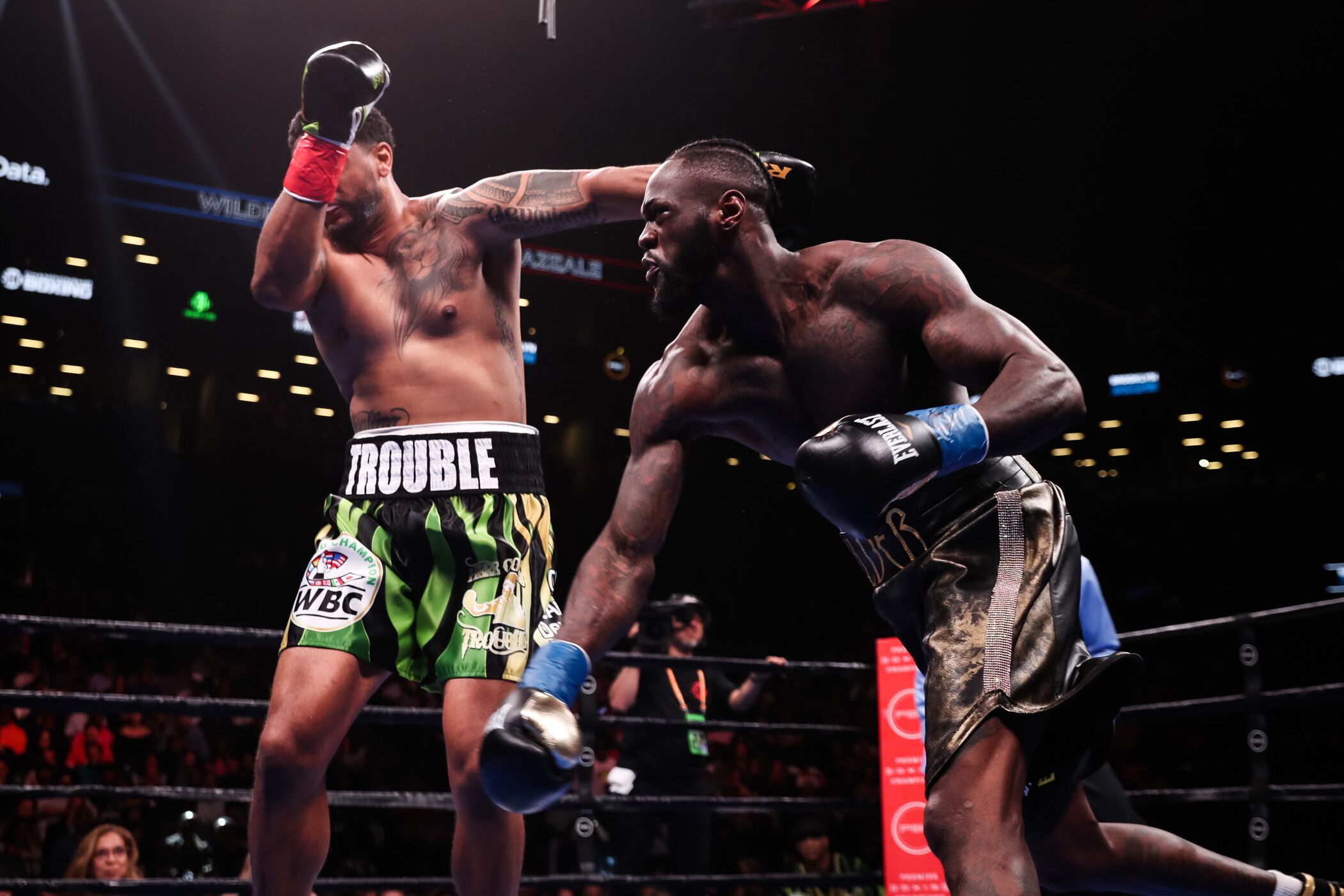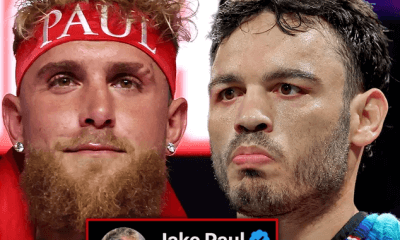Featured Articles
Deontay Wilder’s New Nuances Almost as Startling as His Trademark Right Hand

How much improvement can a fighter, any fighter, demonstrate in only 137 seconds? How many sandpaper-rough stylistic edges can be smoothed in that comparatively brief snippet of time?
Before WBC heavyweight champion Deontay Wilder entered the ring at the Barclays Center in Brooklyn Saturday night, the one thing everyone knew he had was a booming right hand that had accounted for virtually all of his previous 39 knockout victories, 19 of which were one-round quickies. At first glance it appeared another case of the same devastating stuff when Wilder (41-0-1, 40 KOs) landed his signature shot with less than a minute remaining in the opening round. Semi-conscious challenger Dominic Breazeale (20-2, 18 KOs) crashed onto his back, his arms and legs outstretched as if he were being spread-eagled, with referee Harvey Dock going through the formality of counting him out after an elapsed time of 2 minutes, 17 seconds.
But it was in those two-plus minutes prior to an ending that everyone in the live turnout of 13,181 and a Showtime audience should have expected that Wilder, at the relatively advanced age of 33, revealed that he might be more than a one-trick pony. This Wilder didn’t just use his boarding-house-reach of a jab as a range finder; he snapped it out with some authority. He threw and landed an early left hook to the body, notable because the Wilder with whom fight fans were familiar was almost exclusively a headhunter. And, most telling of all, the two big right hands that did find the mark – he got Breazeale’s attention prior to the putaway blow with one that didn’t quite land flush – weren’t his typical roundhouses.
“The quickest point from A to B is always that straight line, that right hand straight down the middle,” color analyst Paulie Malignaggi said of what would appear to be a new and improved version of Wilder’s weapon of choice.
“I’m an intelligent fighter. I’m very smart in the ring with the way I set these guys up,” Wilder said at the post-fight press conference. But if that were so, these additional wrinkles or nuances would have been unveiled earlier in a career that hasn’t always been as appreciated as it might have been. He is still trained by Jay Deas and Mark Breland, so the logical conclusion is that what they likely have been telling him all along in the gym must finally have sunk in. If that is indeed the case, then Wilder, whose startling power when unleashed in any form made him an omnipresent threat, had in those 137 seconds transformed himself into an even more dangerous dude.
They say history has a way of repeating itself. Another large heavyweight of considerable renown, Lennox Lewis, fought much like the unpolished Wilder in the formative stages of his Hall of Fame career. But after Lewis relinquished his WBC title to seemingly no-hope challenger Oliver McCall, who dropped and then stopped him in the second round on May 13, 1995, in London, he fired trainer Pepe Correa and replaced him with Emanuel Steward, who had worked McCall’s corner the night “The Lion” became an ex-champ. Steward, a brilliant tactician, radically retooled Lewis, especially his jab, which was upgraded from pawing range-finder to the instrument that made the big Briton’s overhand right even more effective. Following perfunctory TKOs of Lionel Butler and Justin Fortune in his next two bouts, the best of Lewis was revealed on Oct. 7, 1995, in Atlantic City, N.J., when he floored a bloodied Tommy Morrison four times en route to winning via a sixth-round stoppage.
“I really feel like I have one of the superior jabs in the heavyweight division right now,” a beaming Lewis said after that fight, in which he showcased not only his spiffy new jab but a left hook that the pre-Steward version seldom dared to employ. “I wanted to see how Tommy Morrison would contend with it. The first couple of rounds, he contended with it. But as the rounds went by, I found my jab started to get to him.”
Is Wilder going to continue to utilize more of the tools in what would appear to be an expanded tool box? Difficult to predict. As sample sizes go, 137 seconds isn’t much. Even his destruction of the limited Breazeale may not be conclusive proof that he has matched or supplanted Anthony Joshua (22-0, 21 KOs) atop the heavyweight heap. The Englishman has three bejeweled championship belts (IBF, WBA, WBO) to Wilder’s one, and he is a wide favorite to retain them when he takes on late substitute challenger Andy Ruiz Jr. (32-1, 21 KOs) in Joshua’s U.S. debut June 1 in Madison Square Garden. There also are those who are convinced lineal champ Tyson Fury (27-0-1, 19 KOs) is superior to Wilder, despite the fact Wilder dropped him twice in their Dec. 1 bout last year that ended in a split draw. Unless or until Wilder again faces Fury, or Joshua, he will be obliged to continue convincing however many doubters remain unswayed by his string of exclamation-point knockouts.
“I display greatness when I step in the ring,” Wilder said. “I put fear in any man. I know I have tremendous power. That’s no secret. At this point I think I’ve proved myself, with the record that I have and many a body that done hit the canvas.”
Truth be told, it is becoming more and more difficult to dismiss Wilder as a crude, wild-swinging brawler who was absent the day fundamental boxing skills were being taught. You want to say that some of the nine title defenses he’s made were against fringe contenders that didn’t exactly constitute a Murderer’s Row? Fine, but he went toe-to-toe with Luis Ortiz and weathered a few sticky moments before winning on a 10th-round stoppage, and he came ever so close to knocking out Fury in the 12th round, a rare late bolt of lightning that likely preserved his undefeated record. Oh, and don’t forget that he was willing to go to Moscow to defend his title against Russia’s Alexander Povetkin, a bout which was scrapped when Povetkin tested positive for performance-enhancing drugs.
“Deontay will fight anyone,” said his co-manager, Shelly Finkel, who previously worked with, among others, Evander Holyfield and Mike Tyson. “He was willing to fight Joshua for very little comparative to what he was worth. When someone wants to make a fight, they make it. When we wanted to get Fury, we overpaid him. We gave him anything he wanted in order to make the fight.”
There almost certainly will be more concessions made by Team Wilder to procure a date with Joshua, not the least of which will be the requirement to travel to the United Kingdom, where Joshua sells out soccer stadiums. Joshua, who had handed Breazeale his only previous defeat, by seventh-round TKO on June 26, 2016, had publicly stated that he hoped Breazeale would last at least until the eighth round against Wilder, if only to keep up appearances.
Maybe he isn’t the least flawed of heavyweights, but with his ninth consecutive heavyweight title defense – matching the number for sixth place all time shared by Muhammad Ali, Joe Frazier, Vitali Klitschko, Lewis and Tyson – he has entered the conversation for being one of the hardest-punching of big men. It is not yet where he wants to be, but as a launching pad for bigger and better things, it ain’t half-bad.
The Real Godzilla is 5-foot-5 and 118 pounds
As impressive as the bomb Wilder detonated on Breazeale’s jaw, the top performance of the day came half a world away, in Glasgow, Scotland, where Japan’s Naoya Inoue (18-0, 16 KOs), whose nickname is “The Monster,” looked like the best pound-for-pound fighter in the world with his second-round knockout of Puerto Rico’s Emmanuel Rodriguez (19-1, 12 KOs), the IBF bantamweight champion, in the semifinals of the World Boxing Super Series. Until Inoue floored him three times with left hooks Joe Frazier would have been proud of, Rodriguez, his face contorted in agony on each trip to the canvas, had never been knocked down as a professional.
Inoue’s victory moves him into the WBSS 118-pound final against veteran Nonito Donaire (40-5, 26 KOs), the WBA and WBC Diamond titlist who also has a pretty good left hook.
So dominant has the 26-year-old Inoue been that there were immediate suggestions he move up – way up – in the pound-for-pound ratings, maybe far enough up to supplant Vasiliy Lomachenko or Terence Crawford at No. 1, depending on which list you choose to believe. It’s a reason for legitimate discussion, because Inoue really is that good. Maybe he already has done enough to rise above the great Hall of Famer Fighting Harada as the best ever from the Land of the Rising Sun.
Photo credit: Amanda Westcott / SHOWTIME
Check out more boxing news on video at The Boxing Channel
To comment on this story in The Fight Forum CLICK HERE
-

 Featured Articles4 weeks ago
Featured Articles4 weeks agoAvila Perspective, Chap. 330: Matchroom in New York plus the Latest on Canelo-Crawford
-

 Featured Articles3 weeks ago
Featured Articles3 weeks agoVito Mielnicki Jr Whitewashes Kamil Gardzielik Before the Home Folks in Newark
-

 Featured Articles17 hours ago
Featured Articles17 hours agoResults and Recaps from New York Where Taylor Edged Serrano Once Again
-

 Featured Articles4 weeks ago
Featured Articles4 weeks agoCatching Up with Clay Moyle Who Talks About His Massive Collection of Boxing Books
-

 Featured Articles5 days ago
Featured Articles5 days agoFrom a Sympathetic Figure to a Pariah: The Travails of Julio Cesar Chavez Jr
-

 Featured Articles3 weeks ago
Featured Articles3 weeks agoMore Medals for Hawaii’s Patricio Family at the USA Boxing Summer Festival
-

 Featured Articles7 days ago
Featured Articles7 days agoCatterall vs Eubank Ends Prematurely; Catterall Wins a Technical Decision
-

 Featured Articles4 weeks ago
Featured Articles4 weeks agoRichardson Hitchins Batters and Stops George Kambosos at Madison Square Garden




















